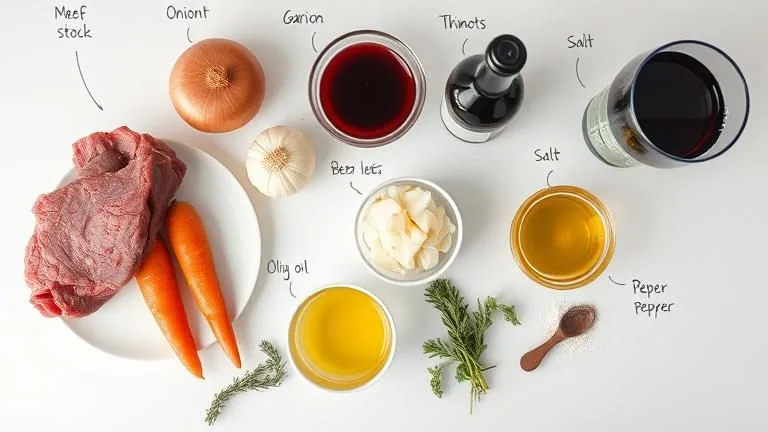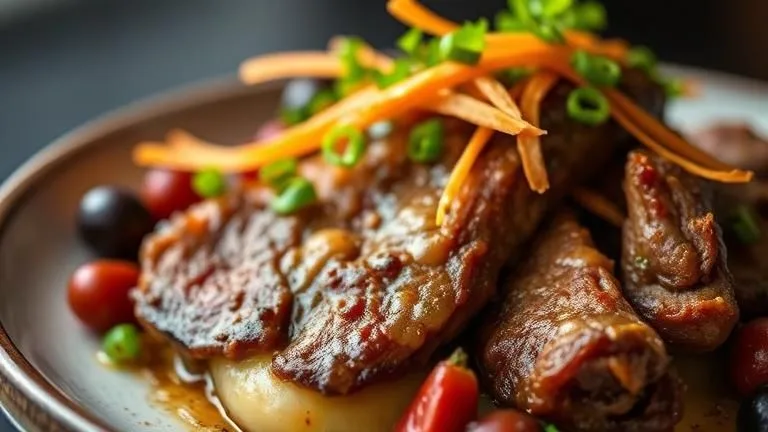Are you aware that beef cheek meat, often overlooked, is one of the most flavorful and tender cuts you can incorporate into your home cooking? While many home cooks rely on popular options like sirloin or flank steak, they may miss out on the unparalleled richness and depth that beef cheek meat brings to the table. If you’re curious about how to elevate your meals using this delicious cut, you’ve come to the right place! Let’s dive into the world of beef cheek meat with mouthwatering recipes and tips.
Ingredients List
When preparing a dish with beef cheek meat, using fresh, high-quality ingredients can make a world of difference. Here’s what you’ll need:
- 2 pounds of beef cheek meat
- 1 large onion, chopped (sweet onions work wonderfully)
- 2 carrots, diced (or substitute with parsnips for a slightly sweeter flavor)
- 2 celery stalks, chopped
- 4 cloves of garlic, minced
- 1 cup of red wine (optional, but enhances the flavor; feel free to use vegetable broth for a non-alcoholic version)
- 2 cups of beef broth
- 2 tablespoons of tomato paste
- 1 tablespoon of fresh thyme (or 1 teaspoon of dried thyme)
- Salt and freshly ground black pepper, to taste
- 2 tablespoons olive oil (you can swap this for avocado oil for a milder taste)
- 1 bay leaf

These ingredients not only complement the beef cheek meat but also create a robust, savory base for your meal. Feel free to experiment with herbs and spices to match your unique palate!
Timing
Preparing beef cheek meat is a labor of love that pays off with dividends in flavor and tenderness! Here’s a breakdown of the timing involved:
- Preparation Time: 15 minutes
- Cooking Time: 2 hours and 30 minutes
- Total Time: 2 hours and 45 minutes
This cooking time may feel lengthy, but compared to other slow-cooked meats that can take up to 4 hours, you’ll be delightfully surprised at how efficiently you can create a gourmet dish.
Step-by-Step Instructions
Step 1: Prepare the Beef Cheek Meat
Start by trimming any excess fat from the beef cheek meat. Cut it into large chunks, about 2 inches thick. Season generously with salt and freshly ground black pepper.
Step 2: Sear for Depth of Flavor
In a large Dutch oven or heavy pot, heat the olive oil over medium-high heat. Add the beef cheek meat chunks, searing them for about 3-4 minutes on each side until they achieve a rich, golden-brown crust. This step is crucial; it locks in the flavors!
Step 3: Sauté the Aromatics
Once the meat is seared, remove it from the pot and set it aside. In the same pot, add the chopped onions, carrots, and celery. Sauté for another 5-7 minutes, until they begin to caramelize. Stir in minced garlic and cook for an additional minute, releasing their fragrant aroma.
Step 4: Deglaze the Pot
Pour in the red wine, scraping the bottom of the pot to loosen any flavorful bits stuck there. Let simmer for a few minutes until the wine reduces by half. This step adds complexity to your dish.
Step 5: Add Broth and Seasonings
Return the beef cheek meat to the pot. Add the beef broth, tomato paste, thyme, and bay leaf. Bring everything to a gentle simmer.
Step 6: Slow Cook for Tenderness
Cover the pot with a lid and transfer it to a preheated oven at 325°F (163°C). Let it cook slowly for about 2 to 2.5 hours until the beef is tender and can be easily shredded with a fork.
Nutritional Information
Here’s a comprehensive overview of the nutritional profile of this beef cheek meat dish per serving:
| Nutrient | Amount per Serving |
|---|---|
| Calories | 380 |
| Protein | 36g |
| Total Fat | 20g |
| Saturated Fat | 7g |
| Carbohydrates | 12g |
| Fiber | 2g |
| Sugar | 3g |
| Sodium | 460mg |
This data highlights the protein-rich aspect of beef cheek meat, making it a great choice for those looking to build muscle.
Healthier Alternatives for the Recipe
If you’re looking to make this recipe healthier without sacrificing flavor, consider these modifications:
- Use Leaner Cuts: If you prefer a lower-fat option, consider using beef shank as an alternative.
- Broth Over Wine: Using vegetable broth instead of wine removes any added sugars from the alcohol, keeping your dish lighter.
- Add More Vegetables: Incorporate mushrooms, bell peppers, or spinach to increase the nutritional content while adding unique flavors.
Serving Suggestions
Beef cheek meat pairs well with various sides, enhancing its rich flavor profile:
- Serve it over creamy mashed potatoes for a comforting touch.
- Pair it with polenta for a creamy, Italian-inspired dish.
- Accompany with a side of sautéed greens (like kale or spinach) to add freshness to your plate.
Common Mistakes to Avoid
Cook with confidence by steering clear of these common pitfalls:
- Not Searing the Meat: Skipping this step can result in a lack of depth in flavor. Remember, the Maillard reaction is your friend!
- Overcrowding the Pot: When searing, give the meat enough space to allow for proper browning.
- Rushing the Cooking Time: Beef cheek meat requires slow cooking to achieve optimal tenderness. Adhere to recommended cooking times for best results.
Storing Tips for the Recipe
If you have leftovers (which would be a delightful surprise), here are some storing tips:
- Refrigeration: Store in an airtight container in the refrigerator for up to 3-4 days.
- Freezing: Place in a freezer-safe container and it can last up to 3 months. To reheat, thaw overnight in the fridge and warm slowly over low heat to retain moisture.
Conclusion
Cooking with beef cheek meat may just be your new culinary adventure. With its rich flavor and versatility, it’s a superb choice for your next home-cooked meal. Try out the recipe, savor your delicious creation, and feel free to share your feedback or explore other exciting recipes that showcase this underappreciated cut.
FAQs
How do I know if beef cheek meat is cooked properly?
Beef cheek meat is cooked properly when it is fork-tender. You should be able to shred it easily.
Can I make this recipe in a slow cooker?
Absolutely! Sear the meat and sauté the vegetables, then transfer everything to a slow cooker and cook on low for 6-8 hours.
What is the best wine to use for this recipe?
A full-bodied red wine like Cabernet Sauvignon or Merlot works beautifully, but feel free to use whatever you have on hand.
For more information about cooking techniques and recipes, check out this trusted source: Serious Eats.
Give Your Feedback On this Recipe
There are no reviews yet. Be the first one to write one.

